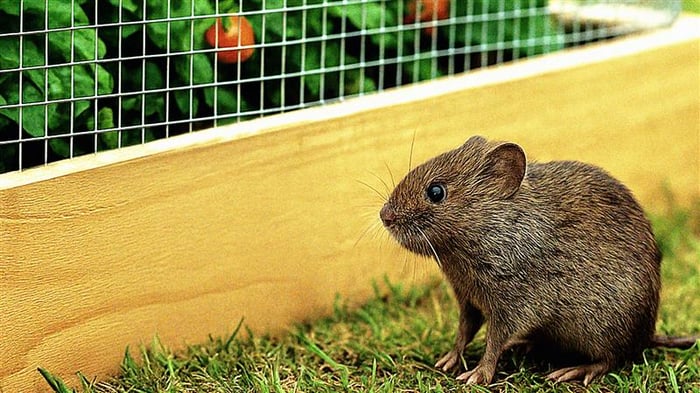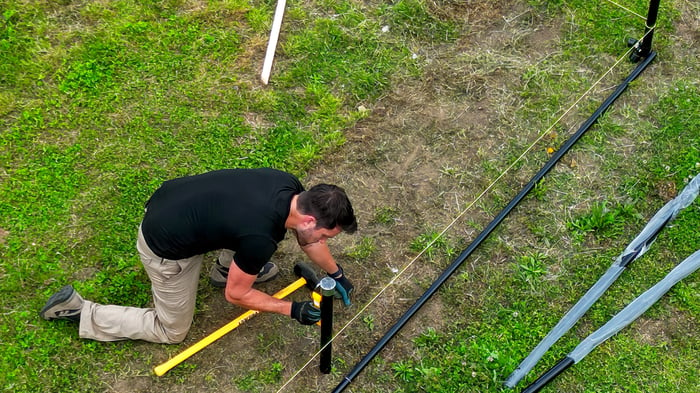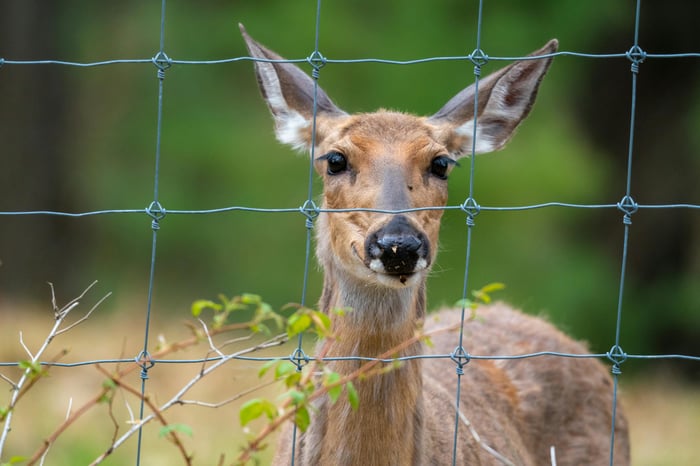
How to Keep Fruit Trees Safe From Animals, Weather, and Wind
Planting a fruit tree is the easy part. Keeping it alive through its first few years is where most people run into trouble. Deer, rabbits, and even mice see young trees as a food source, while harsh winds or a late frost can set growth back by an entire season. With the proper protection in place, you can help your trees push through those vulnerable early years and set them up for decades of strong harvests.
Why Young Fruit Trees Need Extra Care
Young fruit trees are fragile for two main reasons: their roots are shallow, and their bark is tender. In the first three to five years, most of the tree’s energy is spent developing its root system. That means less strength to withstand stress above the soil line. A single bad winter or too much chewing from wildlife can kill the tree outright or leave lasting damage that reduces future yields.
When trees are given extra care during this stage, the payoff is significant. Stronger root systems mean better access to water and nutrients during drought. A tree that survives its first five years with minimal damage will also produce higher-quality fruit and live significantly longer. Protected fruit trees survive to adulthood 85% of the time, while unprotected trees have a survival rate of only 50%. That difference can be the deciding factor between a lush, fruit-bearing orchard and a row of lifeless stumps.
Protecting Fruit Trees From Animals
To help you make the best choices for your fruit trees, let’s look at the specific materials commonly used for protection. Understanding the pros and cons of each will help you select the most effective and durable solutions for your needs.
Deer and Large Wildlife
Deer can do major damage fast. In spring and summer, they browse leaves and buds, stunting growth. In fall and winter, they strip bark by rubbing their antlers on young trunks, which can snap branches or even kill a tree if the bark is peeled away in a circle.
The gold standard of prevention is fencing. To reliably keep deer out, the fence should be at least eight feet tall— anything smaller and you might find a whitetail deer clearing it with little effort. If you have small orchards or backyard trees, a single-tree cage made from welded wire fencing (with 2x4-inch openings) works well.
For larger plantings, metal deer fencing is a better long-term solution. Unlike plastic netting, which deer can push through or get tangled in, metal fencing holds up to pressure and lasts for years. To get the best results, space posts no more than 10 feet apart — it helps the fence stand firm against snow buildup or curious deer leaning in.
Rodents, Rabbits, and Small Animals
Small animals attack trees differently from deer. Rabbits, voles, and mice gnaw at the base of trunks, usually under snow cover in winter when food is scarce. They can chew through the bark to the cambium layer, and if they girdle the trunk (chew all the way around), the tree won’t survive.
Tree guards are the most practical way to prevent this. Plastic spiral guards are cheap and easy to install, but they need to be checked often because they can trap moisture against the bark and attract insects. Solid plastic tubes provide better coverage, though they can become brittle in sunlight over time. Metal mesh guards — often called hardware cloth — are the most durable option. Cut them to about 18–24 inches high and bury the bottom an inch or two in soil to keep rodents from tunneling underneath. Many growers also use deer tree guards, which are tall enough to protect against both rabbit chewing at the base and deer browsing higher up.

Protecting Fruit Trees From Wind and Weather
Effective tree protection also involves safeguarding against forces of nature. Here’s how to shield your fruit trees from wind, harsh temperatures, and frost damage.
Wind Protection for Fruit Trees
Young fruit trees bend easily under strong winds because their roots aren’t yet deep or broad enough to anchor them. Repeated wind stress can loosen roots, dry out soil, and snap tender branches. In open areas, unprotected trees may lean permanently or fail to thrive.
The most common solution is staking. A sturdy stake gives the tree temporary support while roots establish themselves. However, staking should only be used when necessary—such as for bare-root trees, top-heavy trees, or those planted in very windy sites. Over-staking can actually harm a tree by preventing it from developing its own strength and flexibility. For best results, learn how to stake a fruit tree properly: attach the tree loosely enough that it can still sway, which encourages stronger trunk and root development.
Windbreaks are another practical method, especially in orchards. Rows of shrubs, fences, or even purpose-built windbreak fencing reduce wind speed and shield trees without relying on individual stakes.
Choosing the Best Tree Stakes
Not all stakes are created equal, and the right choice depends on how long you need the support to last and the conditions your trees face.
- Wood stakes: Affordable and easy to find, wood stakes work well for short-term support. However, they can rot after a few seasons and may snap in heavy winds or wet conditions.
- Plastic stakes: Resistant to rot and lightweight, plastic stakes are a step up from wood. Their downside is durability: they can bend, crack, or become brittle after extended sun exposure.
- Metal tree stakes: The strongest and longest-lasting option. They don’t rot, warp, or snap, making them the most reliable choice for orchards and growers who want reusable equipment year after year.
When installing stakes, placement is just as important as the material. Drive the stake at least 18 inches into firm soil, ideally on the side of the prevailing wind. Attach the tree loosely about one-third of the way up its trunk with a flexible tie that won’t cut into the bark.
Temperature Fluctuations and Frost
Frost is another silent threat to fruit trees. Early spring frosts can kill developing buds, while late cold snaps may damage tender leaves and flowers. A sudden freeze can wipe out an entire season’s crop.
For home gardeners, frost blankets or row covers offer quick, reusable protection. Laying down mulch also helps insulate roots and moderate soil temperatures. Light watering before a frost can create a thin layer of ice that protects buds from colder air. This trick can be especially useful in small gardens.
For small orchardists, large-scale solutions like wind machines, overhead irrigation systems, or frost fans may be more practical. The right approach depends on your scale: hobby growers can often get by with simple covers, while orchard owners may need to invest in more robust frost-control methods.
Materials That Work Best for Fruit Tree Protection
When it comes to protecting fruit trees, materials matter as much as the method.
- Fencing: Plastic netting is lightweight and great for temporary protection, but not reliable against deer. Metal fencing is stronger, longer-lasting, and worth the investment for orchards.
- Stakes: Wood is inexpensive but short-lived. Plastic holds up moderately well, while metal tree stakes provide the best long-term value.
- Guards and Wraps: Plastic tree guards are affordable but can trap moisture; mesh or metal guards resist chewing and last longer.
- Frost Protection: Fabric blankets and row covers are easy to reuse for hobbyists, while commercial orchardists benefit more from irrigation or wind machines.
For backyard gardeners, affordability and ease of use usually matter most. Orchardists, on the other hand, often find it more cost-effective to spend more upfront on materials that last for multiple seasons.

Creating a Year-Round Tree Protection Plan
Protecting fruit trees isn’t a one-time task — it’s a year-round process that changes with the seasons.
- Spring: Late frosts are a major threat, so keep frost blankets or covers handy and mulch around the base to insulate roots.
- Summer: Young trees face strong winds and dry conditions; stake where needed, water consistently, and maintain windbreaks.
- Fall: As food sources dwindle, deer and rabbits become more aggressive. Install or check guards and fencing before damage occurs.
- Winter: Snow and ice bring two dangers: heavy loads that can break branches and rodents that chew bark under cover of snow. Guard trunks and gently shake off excess snow when safe.
As trees mature, revisit their protection. Guards, wraps, and ties can quickly become too tight and cause more harm than good if not adjusted. Regular monitoring and minor seasonal adjustments are what keep fruit trees healthy, productive, and long-lived.
Healthy fruit trees don’t happen by accident. They’re the result of consistent protection from animals, weather, and seasonal stress. By investing in the proper fencing, stakes, guards, and frost protection, you’ll give your trees the best chance to grow strong roots, live longer, and produce more abundant harvests year after year. A little effort up front pays off in decades of beauty and fruit.
Ready to safeguard your orchard or backyard trees? Contact DeerBusters today for a free quote and get expert guidance on choosing the right tree protection products for your needs.
FAQs
How Tall Should Deer Fencing Be for Fruit Trees?
Deer can easily clear short barriers, so fencing around fruit trees should be 8 feet tall. This ensures they cannot jump over and access young trees. For larger orchards, perimeter deer fencing is often the most effective option. Metal deer fencing provides durability and long-term protection, especially in areas with high deer activity.
Do All Young Fruit Trees Need To Be Staked?
Not every tree requires staking, but young fruit trees often benefit from extra support in their first few years. Staking is especially important in windy areas, sandy soils, or where trees have small root systems. The key is to use durable materials, like metal tree stakes, and avoid staking too tightly, which can limit natural trunk development.
What Type of Tree Stakes Are Best for Orchards?
Metal tree stakes are the most reliable option for orchards because they resist rot, pests, and weather damage better than wood or plastic stakes. They provide stable, long-term support that you can reuse season after season. Wooden stakes may work temporarily, but they are more prone to breaking down over time.
How Do I Protect Fruit Trees From Rabbits and Rodents?
Small animals like rabbits and rodents often chew the bark at the base of young trees, which can kill the tree if left unchecked. Installing tree guards or wraps around the trunk is the best defense. Plastic guards offer an affordable solution, while metal mesh guards provide stronger protection against persistent pests.
Can Frost Damage Young Fruit Trees?
Yes, frost can be especially harmful to young fruit trees, damaging buds and slowing growth. To reduce the risk, use frost blankets during early spring cold snaps and apply mulch around the base to regulate soil temperature. For small orchards, installing windbreaks can also help minimize frost exposure.
How Long Should Tree Guards Stay on Fruit Trees?
Tree guards should generally stay on until the bark has thickened and the tree is less vulnerable to animal damage—usually 2 to 3 years. It’s essential to check the guards regularly to make sure they aren’t restricting growth or trapping moisture against the trunk.
What’s the Best All-Around Way To Protect a Small Orchard?
For small orchards, a combination of tools works best. Deer fencing provides perimeter protection, while tree guards defend against rodents and rabbits. Metal tree stakes add wind resistance, and frost blankets or mulching help regulate temperature. Together, these methods give year-round protection and help trees grow strong and productive.

